Gersten J.I., Smith F.W. The Physics and Chemistry of Materials
Подождите немного. Документ загружается.

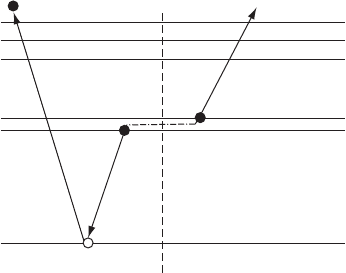
464 CHARACTERIZATION OF MATERIALS
is ionized, leaving a K-shell hole behind. In intermediate atomic-number elements
(Al–Nb) the core hole might be in the L shell, and in still heavier elements (Zr–Au)
in the M shell. (The various shells are actually themselves split into subshells by both
fine-structure splitting and crystal-field splitting. Thus one may refer to the L-I, L-II,
L-III subshells, etc.)
Upon formation of the hole, the ion is left in an excited state. An electron from
some higher-energy shell (which may be broadened into a band) can fill the vacancy,
but first it must get rid of its excess energy. Suppose, for example, that a K-shell hole
is created and is to be filled by an electron falling from the L shell. There are two
methods by which the L-shell electron can shed its excess energy. One is by emitting
an x-ray, whose energy is given by
¯hω D E
L
E
K
.W22.122
The second method is by having the electron make a Coulomb collision with another
electron [e.g., also from a subshell of the L shell (denote it by L
0
)] and transfer the
energy to that electron. The energy of the L
0
electron will then be elevated to
E D E
L
0
C E
L
E
K
.W22.123
If this energy exceeds the vacuum level, some fraction of the Auger-excited L
0
electrons
will be emitted from the solid (Fig. W22.34). Since for the inner shells the energies
E
K
, E
L
,andE
L
0
, are all well defined and vary from atom to atom, the energy E will
also be well defined and will be characteristic of the particular atom involved.
The intensities of the Auger peaks provide quantitative information about the chem-
ical abundance of those elements present. The location of the peaks in the energy
distribution and their line shapes also provide information about their chemical bonding.
In Table W22.2 some characteristic Auger-transition energies are listed.
For light atoms the Auger process is the dominant mode of filling the core hole.
For heavy atoms x-ray emission becomes appreciable. Other possible Auger transi-
tions involve additional shells and/or subshells of the atom. Thus one has K–L–M,
K–M–M, L–M–M, N–O–O, L–M–N processes, and so on. For the upper valence
bands, however, where the band width is large, there will be a broad band of electron
energies emitted and the technique loses its value as an analytical tool.
E
core
M"
M'
M
L'
L
K
Figure W22.34. Auger process. An electron from the L-shell fills the K-shell vacancy and
causes an L
0
electron to be emitted.
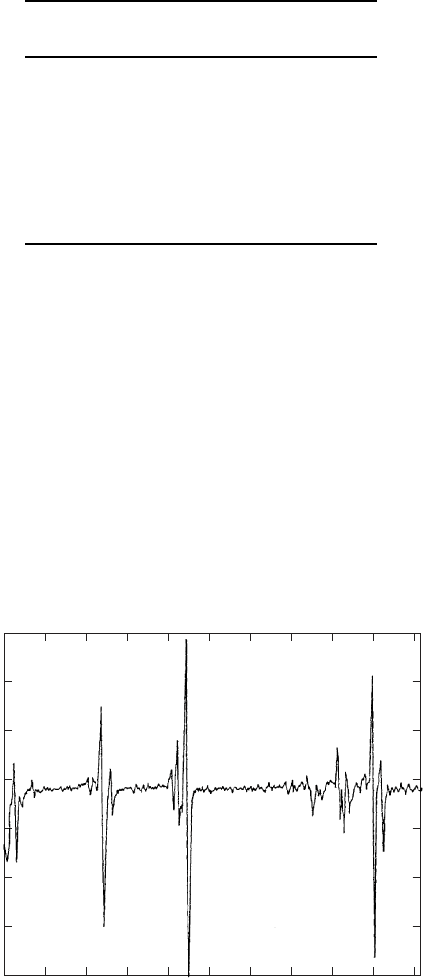
CHARACTERIZATION OF MATERIALS 465
TABLE W22.2 Typical Auger Transitions
and Their Energies
Auger Electron
Atom Transition Energy (eV)
Ag M–N–N 351
Si K–L– L 1619
Al K– L–L 1396
Mg K–L–L 1186
Cu L–M–N 920
Si L–M –M 92.5
Al L – M–M 68
Mg L–M–M 45
The reason that AES is regarded as a surface technique has to do with the mean
free path of electrons in solids. The electrons lose energy by a variety of processes,
including plasmon emission, electron–hole pair excitations, and phonon emission. This
limits the range in which it is possible to get Auger electrons out of the solid to the
vicinity of the first few surface layers.
Auger spectra are usually presented as derivative spectra. This makes the spectra
less sensitive to drifts in the electrical current. The derivatives are obtained by super-
imposing a weak ac component to the incident current and taking the difference in the
Auger current electronically. An example of an Auger spectrum for galvanized steel
exposed to atmospheric corrosion for four days is presented in Fig. W22.35. In the
energy range of interest there are features due to Zn and also atmospheric components
such as O and C present.
110 220 330 440 550 660 770 880 990 1100
Kinetic energy (eV)
Zn
Zn
C
Ca
O
Arbitrary units
Figure W22.35. Auger electron emission spectrum for galvanized steel undergoing atmospheric
corrosion. (From C. Beltran et al., in F. A. Ponce and M. Cardona, eds., Surface Science,
Springer–Verlag, Berlin, 1991.)

466 CHARACTERIZATION OF MATERIALS
Sometimes, instead of using atomic notation such as L–M–M one denotes the
process by L–V–V, indicating that the valence bands (V) are considerably broader
than the atomic levels.
W22.20 Secondary-Ion Mass Spectrometry
Sputtering is the process whereby a beam of energetic ions is directed at the surface
of a solid and atomic and molecular fragments of the solid are ejected. The fragments
may be electrically charged or neutral. In secondary-ion mass spectrometry (SIMS) a
quantitative analysis of the emerging ion constituents is undertaken using a mass spec-
trometer. Often, the emerging neutrals are ionized by external means before the analysis
is made. SIMS provides a powerful technique to study the profile of composition versus
depth in a sample.
SIMS is capable, in principle, of detecting all elements present in the range of parts
per million or even parts per billion. It has a dynamic range of nine orders of magni-
tude, meaning that it may detect dominant atoms as well as impurity atoms present in
low concentrations. It can distinguish different isotopes. Typical depth resolution is on
the order of 10 nm, whereas the focused beam size can be made as small as 100 nm.
Sputtered holes as deep as 30
µm may be bored in the sample. It is therefore possible
to create three-dimensional images of a heterogeneous structure by methodically sput-
tering away the outer layers. Sputtering is also used in conjunction with AES for depth
profiling.
Typically, the energy of the incident ion is in the range 1 to 20 keV. The most often
used ions are O
2
C
and Cs
C
. The oxygen ion is used when the sample is electropositive,
whereas the cesium ion is used when the sample is electronegative.
In the sputtering process the incident ion makes Coulomb collisions with the ions of
the material. Since the energy of the incident ion is fairly high, to a first approximation,
one may regard the collisions as if they take place between free particles. This permits
the use of conservation laws to analyze the process. Consider the collision of two ions
of masses M
1
and M
2
, respectively. Suppose that particle 1 has momentum p
1
; particle
2 is at rest. After the collision the momenta are p
0
1
and p
0
2
. Momentum conservation
requires that
p
1
D p
0
1
C p
0
2
.W22.124
Energy conservation gives
p
2
1
2M
1
D
p
02
1
2M
1
C
p
02
2
2M
2
.W22.125
Let the angle that p
0
2
makes with p
1
be . Then it follows that
E
0
2
D
4M
1
M
2
[M
1
C M
2
]
2
E
1
cos
2
. W22.126
Let the angle between vectors p
1
and p
0
1
be denoted by . The final energy of particle
1isthen
E
0
1
D E
1
cos C
M
2
2
/M
2
1
sin
2
1 C M
2
/M
1
2
.W22.127

CHARACTERIZATION OF MATERIALS 467
In general, the collisions are not elastic and there is some degree of excitation and
ionization taking place. For the hard collisions (i.e., collisions involving substantial
momentum transfer) that are responsible for sputtering, however, the energy transfer
involved in the moderation of the incident ions is large compared with the ionization
energy. The effects of the weaker collisions responsible for ionization may be studied
separately.
A 10-keV O
2
C
ion has a speed of 2.5 ð10
5
m/s, which greatly exceeds the speed of
sound in solids. The lattice is unable to carry the energy away as phonons. A cascade
of collisions occurs in the region where the incident ion strikes the surface. The energy
of the ion is distributed among the atoms in that region. If the energy per atom exceeds
the cohesive energy of the solid, these atoms are likely to evaporate from the surface.
Some of them will emerge as ions, although most will come out as neutrals. Some of
the emerging ions will be reneutralized on the way out. The probability that a given
species will leave as an ion is very chemical dependent as well as a function of the
nature of the sputtering ion. It is known, for example, that a cesiated surface has a low
work function, whereas an oxygenated surface has a high work function. This could
easily affect the reneutralization probabilities for the emerging ions, since electrons
will have to tunnel out from the solid across a vacuum barrier to reach the emitted
ions as they leave the solid.
Once the ions emerge from the sample, the mass spectrometry may be carried out in
one of three ways. One may use an accelerating cathode to speed up the ions and then
inject them into a uniform magnetic field. Alternatively, one may use a quadrupole
mass spectrometer. Finally, one may make a time-of-flight measurement. The first
method will be examined.
The speed of the positive ion as it passes through the cathode depends on the cathode
voltage V, relative to the sample:
v D
2qV
M
,W22.128
where the initial velocity of the ion as it leaves the solid is negligible. The diameter
of the resulting circular orbit in the magnetic field is
D D
2M
v
qB
,W22.129
where q and M are the charge and mass of the ion and B is the strength of the magnetic
induction. Thus the mass-to-charge ratio is
M
q
D
B
2
D
2
8v
.W22.130
A typical SIMS spectrum of Si exposed to oxygen is presented in Fig. W22.36, where
the number of counts in a detector is plotted as a function of the mass-to-charge ratio
M/Z and where q D Ze. Note that the species ejected reflect the bonding in the solid
and, in particular, that an SiO
2
fragment is not ejected.
W22.21 Rutherford Backscattering
A powerful technique for compositional depth profiling of a solid is Rutherford
backscattering (RBS). Usually, an ˛-particle source is used with its energy on the

468 CHARACTERIZATION OF MATERIALS
Log counts
4
3
2
1
0 10203040506070
M/Z
OSi Si
2
Si
2
OSiO
Figure W22.36. SIMS spectrum for SiO
2
.
order of 1 MeV. The ˛-particle is directed normal to the surface and, when scattered
through an angle >/2, exits through the same surface that it entered. The energy of
the ˛-particle is measured and the energy loss is determined. This energy loss depends
on how far the particle penetrated the solid and the type of atom responsible for its
deflection.
As a fast charged particle passes an atom it loses energy, primarily by electronically
exciting or ionizing the atom. In a solid, phonon processes or other elementary exci-
tations also come into play. These processes lead to a steady decrease in the energy
of the particle and may be described by an energy loss per unit length. Bethe gave an
approximate theoretical formula for the energy loss per unit distance due to electronic
excitation and ionization:
dE
ds
D
2nZ
2
E
Z
1
e
2
4
0
2
ln
2m
v
2
IE
,W22.131
where Z
1
is the charge state of the projectile (2 for ˛-particles), Z
2
the atomic number
of the target nucleus, E is the energy of the projectile and
v the corresponding speed,
n the concentration of target atoms, m the mass of an electron, and IE the ionization
energy of the target atom. The energy loss is a slowly varying function of the energy
and may be assumed to be constant if the energy-loss range under consideration is
sufficiently small. The precise form of the energy-loss function varies from material to
material and may be determined experimentally by passing beams through thin samples
and measuring the resulting energy loss. It presumably also contains corrections due
to phonon losses.
In addition to the mechanism above, there exists the possibility of energy loss
resulting from hard Coulomb collisions between the ˛-particle and the target nuclei
(i.e., Rutherford scattering). The cross section for these collisions is on the order of a
barn (10
28
m
2
). The differential scattering cross section in the laboratory frame is
d
d
D
Z
1
Z
2
e
2
8
0
E
1
2
[cos C
1 x
2
sin
2
]
2
sin
4
1 x
2
sin
2
,W22.132
where E
1
is the energy of the ˛-particle just prior to scattering and x D M
1
/M
2
.
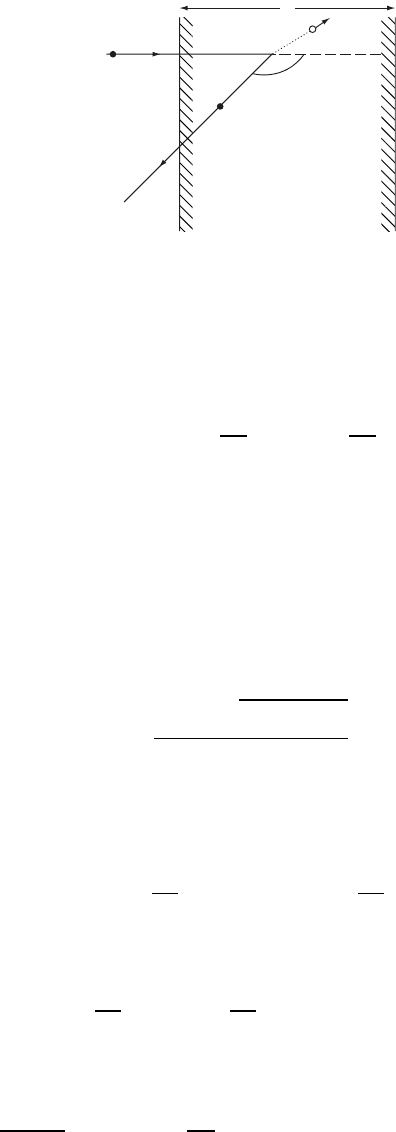
CHARACTERIZATION OF MATERIALS 469
H
D
E'
1
E
1
E
2
E
a
q
Figure W22.37. Rutherford backscattering geometry.
Suppose that the ˛-particle enters the solid with energy E at normal incidence and
travels a distance D before undergoing Rutherford backscattering. It will arrive at the
target nucleus with energy E
1
:
E
1
D E
D
0
ds
dE
ds
' E D
dE
ds
1
,W22.133
where the subscript indicates that the energy-loss function is to be evaluated at an
average energy for the inward journey. The detector is set to measure the backscattered
current at a scattering angle , as in Fig. W22.37. The energy of the projectile just
after the backscattering event is
E
0
1
D FE
1
,W22.134
where it was found in Eq. (W22.127) that
F D
cos C
1/x
2
sin
2
1 C 1/x
2
1.W22.135
The projectile then travels an additional distance D sec before emerging from
the solid. The final energy is
E
2
D E
0
1
D sec
0
dE
ds
ds ' E
0
1
C D sec
dE
ds
2
.W22.136
Here dE/ds is evaluated for the backscattered journey. Thus
E
2
D EF D
dE
ds
1
F
dE
ds
2
sec
EF aD. W22.137
The current entering the detector per unit solid angle per unit energy is
d
P
N
d dE
2
D I
H
0
dD n
d
d
υE
2
C aD EF, W22.138
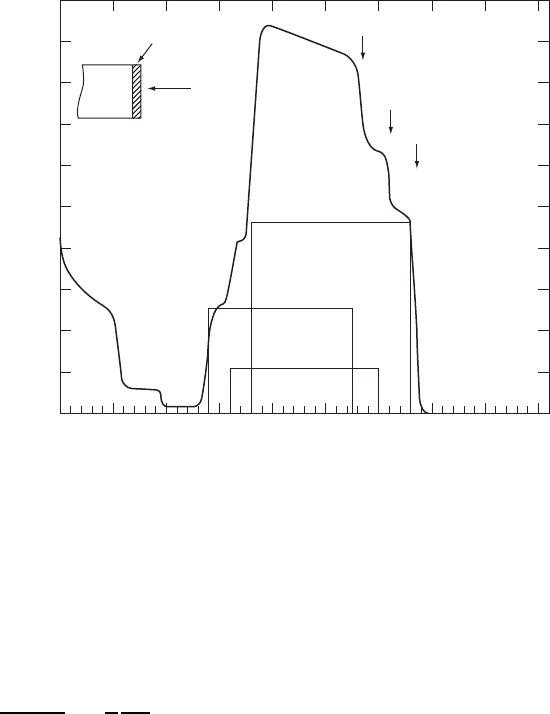
470 CHARACTERIZATION OF MATERIALS
1.7 MeV He
+
Intensity
100 150 200 250 300 350 400 450 500
Channel
Al
2
O
3
YBa
2
Cu
3
O
7−
x
Cu
Cu
Y
Y
Ba
Ba
Figure W22.38. Rutherford backscattering spectrum for 1.7MeV He
C
ions incident on a
YBa
2
Cu
3
O
7x
filmonanAl
2
O
3
substrate. (From H. J. Gossmann and L. C. Feldman, Mater.
Res. Soc. Bull., Aug. 1987, p. 26.)
where I is the incident particle current, a was defined in Eq. (W22.137), H is the sample
thickness, and n is the concentration of target atoms. The delta function ensures the
correct energy relation. Carrying out the integral gives
d
P
N
d dE
2
D I
n
a
d
d
EF E
2
E
2
EF aH. W22.139
The function is 1 for positive argument and 0 for negative argument. It implies the
existence of a high- and a low-energy cutoff in the energy spectrum. The high-energy
cutoff corresponds to scattering from atoms on the front surface of the sample. The
low-energy cutoff corresponds to scattering from atoms at the depth H (i.e., at the
back surface of the sample). Since F is unique to each target atom, the locations
of these cutoffs permits the identification of the presence of a particular type of atom.
The size of the step is proportional to the concentration, n. A typical RBS spectrum
is given in Fig. W22.38 for a thin film of YBa
2
Cu
3
O
7x
. The spectrum consists of
a superposition of rectangles, one for each element, and each with its characteristic
width aH, and energy E
2
extending from EF aH to EF.
SURFACE MICROSCOPY
The next three sections are concerned with scanning surface microscopy. The atomic-
force microscope, the scanning-tunneling microscope, and the lateral-force microscope
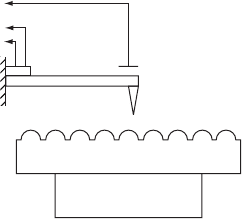
CHARACTERIZATION OF MATERIALS 471
are studied. A mobile probe is passed over the surface in a rastering fashion and a time-
dependent voltage signal is sent by the microscope to a computer, where an image of
the surface is constructed. In the atomic-force microscope the signals are proportional
to the interatomic force between the tip of the probe and the surface. In the scanning-
tunneling microscope it is proportional to the electron current that tunnels between the
probe and the conducting surface. The lateral force microscope rubs the tip over the
surface and measures both the normal force and the frictional force between the solids.
There are numerous extensions of scanning-probe microscopy. The near-field scan-
ning optical microscope (NSOM) uses a tipped optical fiber to transmit light to a
surface and to collect the scattered light, providing information concerning the reflec-
tivity variations of the surface. The scanning-capacitance microscope employs the probe
and substrate as the plates of a capacitor and measures the variation of capacitance
due to variations in the surface height or due to dielectric deposits on the surface.
The scanning-thermal microscope rasters a thermocouple over the surface to measure
differences in local temperature. The scanning magnetic-force microscope probes the
local magnetic structure on the surface by means of a magnetic tip. Numerous other
physical effects are also used as the basis for microscopy.
W22.22 Atomic-Force Microscopy
Two objects brought in proximity will exert forces on each other. This is true of atoms
and molecules and is also true of mesoscopic objects. At the most fundamental level,
this force is of electromagnetic origin (neglecting the extremely weak gravitational
force), although it usually appears in the guise of weak chemical bonding forces.
These include van der Waals forces, the interaction of electric multipole moments with
each other, and possibly magnetic forces as well. The atomic-force microscope (AFM)
uses this force in a controlled way to determine surface structure.
Figure W22.39 is a sketch of the essential elements of the atomic-force microscope.
A sample is mounted on a stage that is capable of being moved in three independent
directions, x, y,andz. A conducting cantilever beam L with a stylus S at the end is
brought close to the surface and the sample is moved in a rastering motion beneath it.
Above the cantilever is a plate which, together with the cantilever, forms a capacitor.
As the sample is moved back and forth, the force on the stylus varies with time. When
the stylus is attracted to the sample, the gap size of the capacitor is increased and the
capacitance decreases. If this capacitor is part of an LC circuit, the resonance frequency
Sample
xyz
S
p
L
Figure W22.39. Atomic-force microscope.
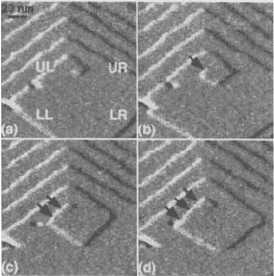
472 CHARACTERIZATION OF MATERIALS
Figure W22.40. Atomic-force microscope micrographs for a growth spiral. [From G. T. Paloczi
et al., Appl. Phys. Lett., 73, 1658 (1998). Copyright 1998, American Institute of Physics.]
may be monitored as a function of time. In another mode of operation, a piezoelectric
crystal, p, attached to the cantilever, can be sent a feedback signal to keep the height
of S above the surface constant. The voltage across the piezoelectric crystal needed to
maintain this constancy then becomes the signal. Other ways of detecting the stylus
motion are possible, such as interferometry.
It is important that the microscope be immune to vibrations of the surrounding
environment. In addition to vibration isolation, such immunity may be obtained by
using a cantilever that has a high natural vibration frequency (in the tens of kilohertz)
and by rigidly attaching it to the sample stage. Then, to a first approximation, the entire
microscope will vibrate as a rigid body and the separation between the stylus and the
sample surface will remain approximately constant.
Since interatomic forces tend to be short ranged, the tip of the stylus provides the
dominant force in its interaction with the sample. The stylus is particularly sensitive
to forces produced by the sample’s dangling bonds, steps, and surface imperfections.
A state-of-the-art atomic-force microscope has recently been constructed with a
cantilever consisting of a single crystal of silicon of dimensions 95
µm long by 0.6 µm
thick. The resonant frequency is 77 kHz and it is sensitive to forces smaller than
10
11
N. A typical scanning velocity is 200 nm/s.
An example of the application of the AFM to the study of a growth spiral is presented
in Fig. W22.40. Sequential images are shown for the outward growth of steps from a
screw dislocation. It is found that when steps reach a critical length, new steps at right
angles to them begin to grow. This is a result of the competition between step-length
energy and layer-area energy. The surface is that of calcite.
W22.23 Scanning-Tunneling Microscope
The scanning-tunneling microscope (STM) uses electrons that tunnel from a conducting
solid to a conducting probe electrode (stylus) to map the topography of the surface of a
solid. The construction is almost identical to that of the atomic-force microscope except
that a potential difference, V, is imposed between the stylus and the surface. A tunneling
current is established, and this current depends sensitively on the distance between the
stylus and the sample. The stylus is made as sharp as possible. Tunneling through
the vacuum favors the most direct path, so the characteristic region of the surface

CHARACTERIZATION OF MATERIALS 473
Stylus
Stylus
(a) (b)
DD
ef
1
ef
2
ef
1
ef
2
ef
1
− ef
2
eV
+ ef
1
− ef
2
eV
E
F
1
E
F
1
Figure W22.41. Tunneling process: (a) unbiased; (b)biased.
contributing tunneling electrons is somewhat smaller than the radius of curvature of
the stylus tip.
As the surface is rastered past the stylus, the distance D between the stylus and the
surface will fluctuate and this will cause the tunneling current to vary. As in the case
of the AFM, it is common practice to supply a feedback voltage to the piezoelectric
crystal to keep the surface at a constant distance below the stylus. This prevents the tip
of the stylus (the “head”) from crashing into the surface, thereby destroying the stylus.
The variation of this feedback voltage with time (and hence stylus location) provides
the signal needed to reconstruct the image of the surface.
It is fairly simple to derive an approximate expression for the tunneling current
in a one-dimensional approximation. Consider Fig. W22.41, which shows two cases
where the stylus is in proximity to the surface, one without external bias and one
with a bias voltage V. For the sake of definiteness, assume that the sample is on the
left and the stylus is on the right in each case. Let
1
be the work function potential
of the sample and
2
be the work function potential of the stylus. When the metals
are brought into contact, or near contact, the Fermi levels will rapidly equilibrate by
having some charge flow from the metal with the smaller work function potential.
This establishes the contact potential difference. (This effect is the basis for what is
called the Kelvin probe technique for measuring work function changes associated with
adsorption.) Next, suppose that an external bias voltage V is imposed on the system.
The Fermi levels are no longer the same and a tunneling current of electrons can flow
from one metal to the other. In the case of the diagram it flows from the sample to the
stylus.
The particle current per unit area is given by an integral over the Fermi sea of the
left-hand conductor:
J
z
D2
dk
2
3
v
z
Pv
z
fE, T[1 fE eV, T],W22.140
where f(E,T) is the Fermi–Dirac distribution function and P is the probability for
tunneling through the barrier. The quantity P is given by
P D
v
0
z
v
z
exp
2
¯h
D
0
2m[Uz E] dz
,W22.141
